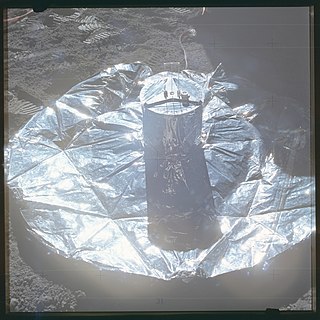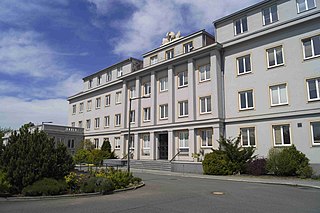
Seismology is the scientific study of earthquakes and the propagation of elastic waves through the Earth or other planetary bodies. It also includes studies of earthquake environmental effects such as tsunamis as well as diverse seismic sources such as volcanic, tectonic, glacial, fluvial, oceanic, atmospheric, and artificial processes such as explosions. A related field that uses geology to infer information regarding past earthquakes is paleoseismology. A recording of Earth motion as a function of time is called a seismogram. A seismologist is a scientist who does research in seismology.
Seismic tomography is a technique for imaging the subsurface of the Earth with seismic waves produced by earthquakes or explosions. P-, S-, and surface waves can be used for tomographic models of different resolutions based on seismic wavelength, wave source distance, and the seismograph array coverage. The data received at seismometers are used to solve an inverse problem, wherein the locations of reflection and refraction of the wave paths are determined. This solution can be used to create 3D images of velocity anomalies which may be interpreted as structural, thermal, or compositional variations. Geoscientists use these images to better understand core, mantle, and plate tectonic processes.
The Lamont–Doherty Earth Observatory (LDEO) is the scientific research center of the Columbia Climate School, and a unit of The Earth Institute at Columbia University. It focuses on climate and earth sciences and is located on a 189-acre campus in Palisades, New York, 18 miles (29 km) north of Manhattan on the Hudson River.

The EarthScope project was an National Science Foundation (NSF) funded earth science program that, from 2003-2018, used geological and geophysical techniques to explore the structure and evolution of the North American continent and to understand the processes controlling earthquakes and volcanoes. The project had three components: USArray, the Plate Boundary Observatory, and the San Andreas Fault Observatory at Depth. Organizations associated with the project included UNAVCO, the Incorporated Research Institutions for Seismology (IRIS), Stanford University, the United States Geological Survey (USGS) and National Aeronautics and Space Administration (NASA). Several international organizations also contributed to the initiative. EarthScope data are publicly accessible.
USArray is one of the three components of the Earthscope project [the other two being the Plate Boundary Observatory (PBO) and the San Andreas Fault Observatory at Depth (SAFOD), funded by the National Science Foundation and being constructed, operated, and maintained as a collaborative effort with UNAVCO Inc., the Incorporated Research Institutions for Seismology (IRIS), and Stanford University, with contributions from several other national and international organizations. A major goal of USArray is to collect detailed seismic images of the North American lithosphere. The data collected from USArray will be integrated with geologic observations made on the earth's surface to help determine the geologic history of North America, as well as to better understand that geologic processes that are at work today. USArray consists of four "observatories":
- the Transportable Array.
- the Flexible Array
- the Reference Network.
- the Magnetotelluric Array.
The Jackson School of Geosciences at The University of Texas at Austin unites the Department of Geological Sciences with two research units, the Institute for Geophysics and the Bureau of Economic Geology.

Paul Gordon Silver was an American seismologist. A member of the research staff at the Department of Terrestrial Magnetism of the Carnegie Institution of Washington since 1982, Paul Silver made a series of important contributions to the investigation of seismic anisotropy and to earthquake research by observing the slow redistribution of stress and strain along fault zones.

Lunar seismology is the study of ground motions of the Moon and the events, typically impacts or moonquakes, that excite them.
UNAVCO was a non-profit university-governed consortium that facilitates geology research and education using geodesy.

John "Jack" Ertle Oliver was an American scientist. Oliver, who earned his PhD at Columbia University in 1953, studied earthquakes and ultimately provided seismic evidence supporting plate tectonics. In the 1960s, Oliver and his former graduate student, Bryan Isacks, set up seismographic stations in the South Pacific to record earthquake activity, and the data collected led to the insight that part of the ocean floor was being pushed downward.
Richard C. Aster is an American seismologist and is Professor of Geophysics and Department Head of Geosciences at Colorado State University.

Weston Observatory is a geophysical research laboratory of the Department of Earth and Environmental Sciences at Boston College. The Observatory is located in the town of Weston, Massachusetts, about 13 miles (21 km) west of downtown Boston.
Anya Marie Reading is a professor of Geophysics and Associate Head of Research in the School of Natural Sciences, University of Tasmania.

Walter D. Mooney is a research seismologist and geophysicist at the United States Geological Survey (USGS), Menlo Park, California (1978–present). He was Chief of the USGS Branch of Seismology from 1994 to 1997.
The World-Wide Standardized Seismograph Network (WWSSN) – originally the World-Wide Network of Seismograph Stations (WWNSS) – was a global network of about 120 seismograph stations built in the 1960s that generated an unprecedented collection of high quality seismic data. This data enabled seismology to become a quantitative science, elucidated the focal mechanisms of earthquakes and the structure of the earth's crust, and contributed to the development of plate tectonic theory. The WWSSN is credited with spurring a renaissance in seismological research.
Alik Ismail-Zadeh is a mathematical geophysicist known for his contribution to computational geodynamics and natural hazard studies, pioneering work on data assimilation in geodynamics as well as for outstanding service to the Earth and space science community. He is Senior Research Fellow at the Karlsruhe Institute of Technology in Germany.
Karen Fischer is an American seismologist known for her research on the structure of Earth's mantle, its lithosphere, and how subduction zones change over geologic history.
Anne Meltzer is a seismologist known for her research on earthquakes and the formation of mountain ranges. Her research primarily focused on the evolution of the earth's lithosphere and the surface processes associated with faulting and deformation in the earth's crust. Through her own personal research and collaboration with other colleagues, she strived to make advancements in the efficiency and effectiveness of monitoring earthquakes. In addition, her work aimed to effectively reduce earthquake destruction in countries that experience frequent seismic phenomena.

MERMAID is a marine scientific instrument platform, short for Mobile Earthquake Recorder for Marine Areas by Independent Divers.

The Institute of Geophysics, GFÚ, is a publicly funded scientific research institution in Prague affiliated with the Czech Academy of Sciences. It focuses on pure and applied research in the Earth and environmental sciences.









